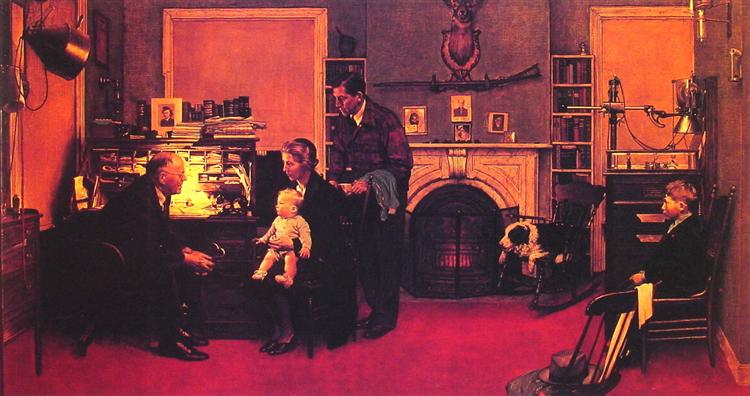Family doctors in short supply in northern New York
Part of the healthcare series, “A picture of health in northern New York.”

“Visits A Country Doctor,” Norman Rockwell, oil on canvas, 1947. Image: Wiki Art, Fair Use
From the star of Norman Rockwell’s famous painting to television cult-series Northern Exposure’s Joel Fleischman, family doctors have always held a special place in the hearts of Americans. Friendly and compassionate caregivers immortalized for the Saturday Evening Post, family doctors are now called, “primary care physicians (PCPs).” Despite the less warm and fuzzy clinical title, primary care physicians are still one of the most important elements of the healthcare system. As a matter of fact, according to some experts, your visit to the family doctor is the most important part of the process.
The buck starts here
The first doctor we see in life is usually a primary care doctor. When they are not giving well-baby checkups, annual physicals, and vaccinations to people of all ages, primary care doctors are the detectives of the healthcare team. The primary care doctor interprets descriptions of symptoms such as, “I just don’t feel good,” and understands what “an achy, throbbing, twisting thing in my stomach” means. They treat a broad array of maladies, from diabetes to asthma to strep throat, and find the right specialist when needed. Primary care physicians are the theoretical coordinators of care, the first stop on the way to wellness.
The golden combination: better care, less money
Studies among industrialized nations show countries that place a greater emphasis on primary care medicine have better healthcare outcomes and spend less money for healthcare. Outcomes are best when 40 to 50 percent of the total physician workforce is made up of PCPs. The Dartmouth Center for the Clinical Evaluative Sciences found states with 40 percent more PCPs per capita have significantly better healthcare quality indicators and lower Medicare costs.
Not enough to go around
Since we already know how the United States is ranked among fellow industrialized nations in healthcare, it will come as no surprise to learn we have a shortage of PCPs in this country. Currently 31 percent of U.S. physicians are primary care doctors.
In New York State, only 43 percent of primary healthcare needs are currently met according to government statistics. In northern New York there are federally designated underserved areas – Health Professional Shortage Areas (HPSA) – for primary care in every county we studied, as outlined on the map below, except Saratoga County.
Copyright ©2016 Joann Sandone Reed. Used with permission.Wanted: doctors who like the outdoors
Despite the essential role of the primary care doctor and the bucolic beauty of rural America, it is difficult to attract young medical school students to the primary care specialty and a rural lifestyle. Students who choose primary care choose to make less money than most other specialties. An orthopedic surgeon can expect to earn a starting salary of around $488,000 versus a sub-$200,000 salary for the beginning primary care physician. It is particularly difficult to attract PCPs to rural areas like northern New York. A lack of cultural opportunities, shopping, and food diversity has been cited by doctors who take a pass on the country life.
Residents who love living in northern New York specifically because of the low population density and access to nature might be surprised to learn not everyone appreciates the daily opportunity to see an eagle on the way to the office. Take for instance Hamilton County, New York, one of the most beautiful natural spots in New York State and home to more deer than humans. With a population of 4,836 there are 2,418 residents for every primary care doctor. Because of the older average age of the citizens of Hamilton County, 23 percent of people are over 65, the population has higher measured need, and they have two doctors. Hamilton County also ranks worst in our region for premature death.
Healthcare reform put emphasis on primary care doctors
Do not despair. The Patient Protection and Affordable Care Act (ACA) put a great deal of emphasis on the role of primary care providers. Experts in the United States now believe patient access to high-quality primary care is essential for a healthcare system that functions well and has high outcomes. The ACA places greater value on primary care and strives to reduce reliance on specialty care. For example, a key provision provides a bonus to primary care clinicians who participate in the Medicare program. The Congressional Budget Office estimated $3.5 billion has been made available to primary care providers from 2011–2016
In our next installment we’ll talk about the good news that shows we as a nation get it – special programs for primary care physicians who agree to rural placements for a prescribed period of time (like those who go reluctantly into the wild a la Dr. Fleischman), increased payments to rural physicians, and physician extenders.
Read more articles on healthcare, A picture of health in northern New York, A Picture of health in northern New York: the players, how they interact, and a free dose of medicine, and Take a hike–doctor’s orders.
As promised, below is a nature photo to offset the information-laden graphic.
Joann Sandone Reed is owner and principal of JSR Associates, a communications firm with special expertise in the healthcare and life sciences industry.
Tags: health, Healthcare, picture of health









That map is very informative, thank you.
It is good to hear that health care policy in this country is starting to be driven by data and experiences about what works in other countries with better, cheaper health care systems. Hopefully the trend continues.
You’re welcome Harold. Yes, fortunately it looks like healthcare policy is trending in a positive direction.
With family members in patient care I am aware of government directing medical practice long before the affordable care act. On dental practice my cousin directed the federal program getting dentists into under-served areas. Today government is saying how much they will pay and insurers take that lead. Government is mandating rates level of care. Without single payor we are getting government directed healthcare.
Hi Jeff, You are right, government has been involved in healthcare since the late 19th century when someone noticed we can impact the spread of disease with protocol to contain it. From the 1840s when the earliest drug safety laws were implemented, to the late 1920s when regulatory standards were designed to keep the public safe from untrained practitioners and ill-equipped facilities, to the ACA, the role of government in healthcare has grown. However, the United States has less government involvement than every other industrialized country in the world, and they all have better outcomes than the U.S.
In the Champlain Valley, we’ve are preparing, with the help of partners at the University of Vermont Health Network, to welcome our first class of family medicine residents to our new Family Medicine Residency Program. It was developed with the assistance of the University of Vermont College of Medicine and the University of Vermont Medical Center to address the chronic PCP shortage here. We’re welcoming our first class of residents in July — 4 of them. Our program also offers a debt relief program to residents (up to $120,000 for those who qualify) who choose to stay in our region after their training is complete. We have confidence that many of them will fall in love with this community and the Adirondacks and will decide to stay here to practice medicine.
This partnership has certainly accelerated the development of the program.
That is great news Chris. Thank you for letting us know. It sounds like a great program and a great opportunity for lucky aspiring physicians!